Energy Efficiency and Sustainability Evaluation of Space and Water Heating in Urban Residential Buildings of the Hot Summer and Cold Winter Zone in China
Abstract
:1. Introduction
2. Description of the HSCW Zone in China
3. Ways of Space and Water Heating in Urban Residential Buildings of the HSCW Zone
4. Methodology
4.1. Definitions of the Indicators in This Study
4.2. Models for the Energy and Exergy Efficiencies of Space Heating Equipments
4.2.1. Air-Source Heat Pumps
4.2.2. Electric Space Heating Equipments
4.2.3. Gas Furnaces
4.3. Models for the Energy and Exergy Efficiencies of Water Heating Equipment/Systems
4.3.1. Electric Water Heaters
4.3.2. Gas Water Heaters
4.3.3. Solar Water Heaters with Auxiliary Electric Heaters
4.3.4. ASHP Water Heaters
4.3.5. ASHP Assisted Solar Hot Water Systems
5. Results and Discussion
5.1. Determination of Parameters
5.2. Calculation Results for Space Heating and Discussion
5.3. Calculation Results for Water Heating and Discussion
6. Conclusions
- The comparison results indicate that electric space and water heating are the most unsustainable ways of space and water heating. There is great potential for improving the quality match between energy supply and demand in urban residential buildings of the HSCW zone. It is suggested that electric space and water heating equipments should be gradually replaced by more sustainable space and water heating equipment/systems.
- The total exergy efficiency of the room air conditioners during heating season was evaluated as 12.33%, and ASHPs are both sustainable and low-cost equipments for space heating of urban residential buildings in the HSCW zone. The PEEs and total exergy efficiencies of ASHP water heaters in the 10 cities were found to range from 104.2% to 112.4% and from 4.8% to 4.9%, respectively. ASHP water heaters are more suitable for application in the cities with relative poor solar energy resources than SWHs with auxiliary electric heaters.
- The PEEs and total exergy efficiencies of ASHP assisted solar hot water systems in the 10 cities were found to range from 193.2% to 341.3% and from 8.3% to 15.9%, respectively. Due to the utilization of two kinds of renewable energies, ASHP assisted solar hot water systems are the most sustainable among currently used water heating equipment/systems.
Acknowledgments
Author Contributions
Conflicts of Interest
References
- Berardi, U. A cross-country comparison of the building energy consumptions and their trends. Resour. Conserv. Recyl. 2016. [Google Scholar] [CrossRef]
- National Economy and Society Developed Statistical Bulletin 2015. Available online: http://www.stats.gov.cn/tjsj/zxfb/201602/t20160229_1323991.html (accessed on 29 February 2016).
- Berardi, U. Sustainability assessment in the construction sector: Rating systems and rated buildings. Sustain. Dev. 2012, 20, 411–424. [Google Scholar] [CrossRef]
- Kotas, T.J. The Exergy Method of Thermal Plant Analysis; Paragon Publishing: Trowbridge, UK, 1995. [Google Scholar]
- Rosen, M.A.; Dincer, I. Exergy analysis of waste emissions. Int. J. Energy Res. 1999, 23, 1153–1163. [Google Scholar] [CrossRef]
- Rosen, M.A.; Dincer, I. Thermoeconomic analysis of power plants: An application to a coal-fired electrical generating station. Energy Convers. Manag. 2003, 44, 2743–2761. [Google Scholar] [CrossRef]
- Rosen, M.A.; Dincer, I.; Kanoglu, M. Role of exergy in increasing efficiency and sustainability and reducing environmental impact. Energy Policy 2008, 36, 128–137. [Google Scholar] [CrossRef]
- Rosen, M.A. Using exergy to correlate energy research investments and efficiencies: Concept and case studies. Entropy 2013, 15, 262–286. [Google Scholar] [CrossRef]
- Dincer, I.; Cengel, Y.A. Energy, entropy and exergy concepts and their roles in thermal engineering. Entropy 2001, 3, 116–149. [Google Scholar] [CrossRef]
- Hammond, G.P. Industrial energy analysis, thermodynamics and sustainability. Appl. Energy 2007, 84, 675–700. [Google Scholar] [CrossRef]
- Cornelissen, R.L. Thermodynamics and Sustainable Development. Ph.D. Thesis, University of Twente, Enschede, The Netherlands, 1997. [Google Scholar]
- Utlu, Z.; Hepbasli, A. A Study on the evaluation of energy utilization efficiency in the Turkish residential–commercial sector using energy and exergy analysis. Energy Build. 2003, 35, 1145–1153. [Google Scholar] [CrossRef]
- Utlu, Z.; Hepbasli, A. Analysis of energy and exergy use of Turkish residential–commercial sector. Energy Environ. 2005, 40, 641–655. [Google Scholar] [CrossRef]
- Dincer, I.; Hussain, M.M.; Al-Zaharnah, I. Analysis of sectoral energy and exergy use of Saudi Arabia. Int. J. Energy Res. 2004, 28, 205–243. [Google Scholar] [CrossRef]
- Al-Ghandoor, A.; Al-Hinti, I.; Akash, B.; Abu-Nada, E. Analysis of energy and exergy use in the Jordanian urban residential sector. Int. J. Exergy 2008, 5, 413–428. [Google Scholar] [CrossRef]
- Saidur, R.; Masjuki, H.H.; Jamaluddin, M.Y. An application of energy and exergy analysis in residential sector of Malaysia. Energy Policy 2007, 35, 1050–1063. [Google Scholar] [CrossRef]
- Armel, T.K.F.; Vidal, A.K.C.; René, T. Energy analysis and exergy utilization in the residential sector of Cameroon. Energy Power Eng. 2015, 7, 93–104. [Google Scholar] [CrossRef]
- Liu, Y.F.; Li, Y.; Wang, D.J. Energy and exergy utilizations of the Chinese urban residential sector. Energy Convers. Manag. 2014, 86, 634–643. [Google Scholar] [CrossRef]
- China National Standard. Thermal Design Code for Civil Buildings; GB 50176-93; China Planning Press: Beijing, China, 1993. [Google Scholar]
- China Industry Standard. Design Standard for Energy Efficiency of Residential Buildings in Hot Summer and Cold Winter Zone; JGJ 134-2010; China Architecture and Building Press: Beijing, China, 2010. [Google Scholar]
- China Meteorological Information Center, Department of Building Science, Tsinghua University. Meteorological Data Sets for Analysis of China Building Thermal Environment; China Architecture and Building Press: Beijing, China, 2005. [Google Scholar]
- Building Energy Conservation Research Center, Tsinghua University. Annual Report on China Building Energy Efficiency 2013; China Architecture & Building Press: Beijing, China, 2013. [Google Scholar]
- Bright Future of Heat Pump Water Heaters. Available online: http://rb.n3.com.cn/show.php?itemid=2687 (accessed on 17 February 2016).
- White Paper on Water Heater Industry in 2014. Available online: http://homea.people.com.cn/n/2014/1215/c41390-26211534.html (accessed on 28 February 2016).
- Stepanov, V.S. Chemical energies and exergies of fuels. Energy 1995, 20, 235–242. [Google Scholar] [CrossRef]
- Yang, Y.P.; Yang, Z.P.; Xu, G. Situation and prospect of energy consumption for China’s thermal power generation. Proc. Chin. Soc. Electr. Eng. 2013, 33, 1–11. (In Chinese) [Google Scholar]
- Li, W.; Rubin, T.H.; Onyina, P.A. Comparing solar water heater popularization policies in China, Israel and Australia: The roles of governments in adopting green innovations. Sustain. Dev. 2013, 21, 634–643. [Google Scholar] [CrossRef]

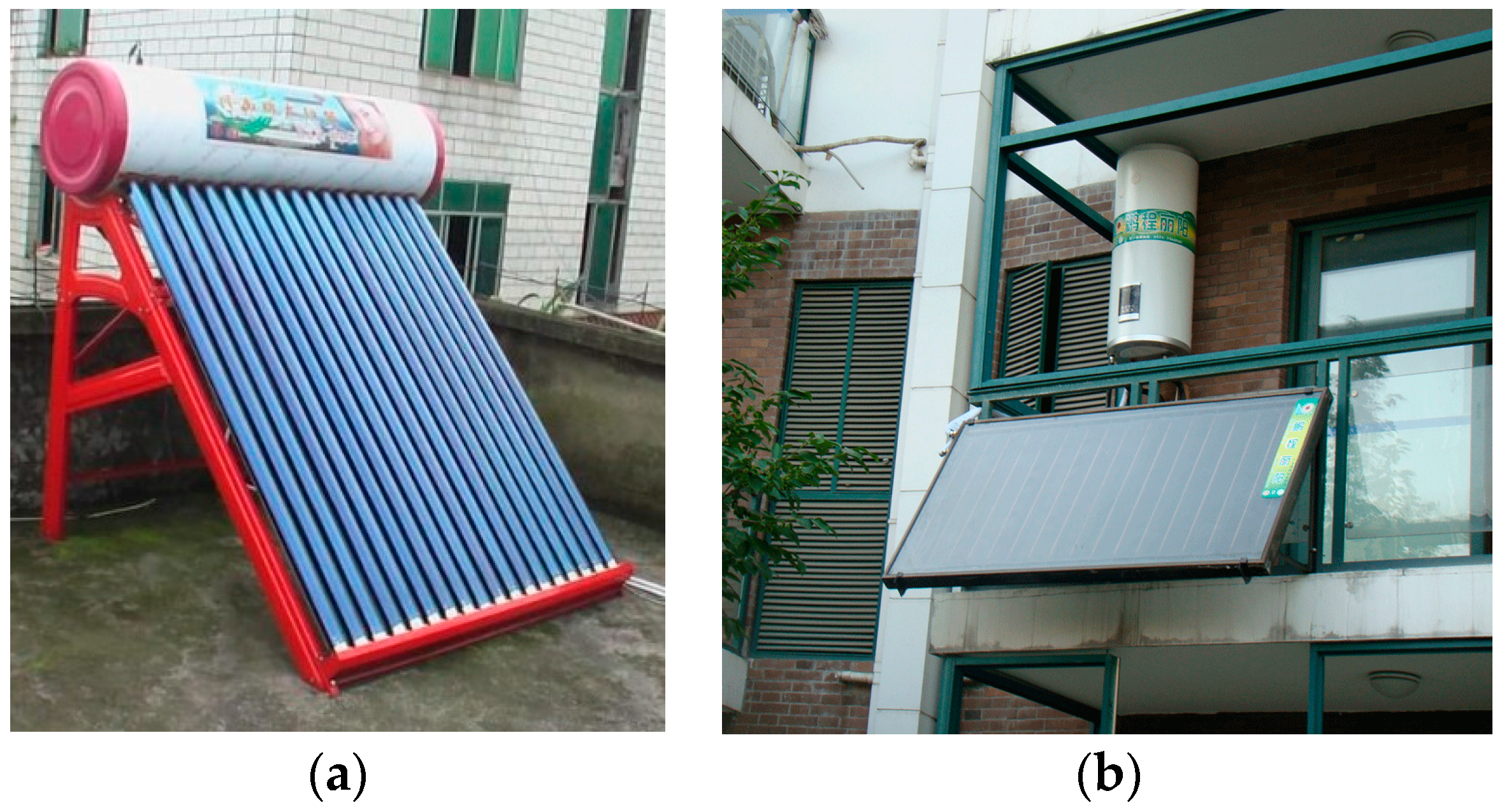
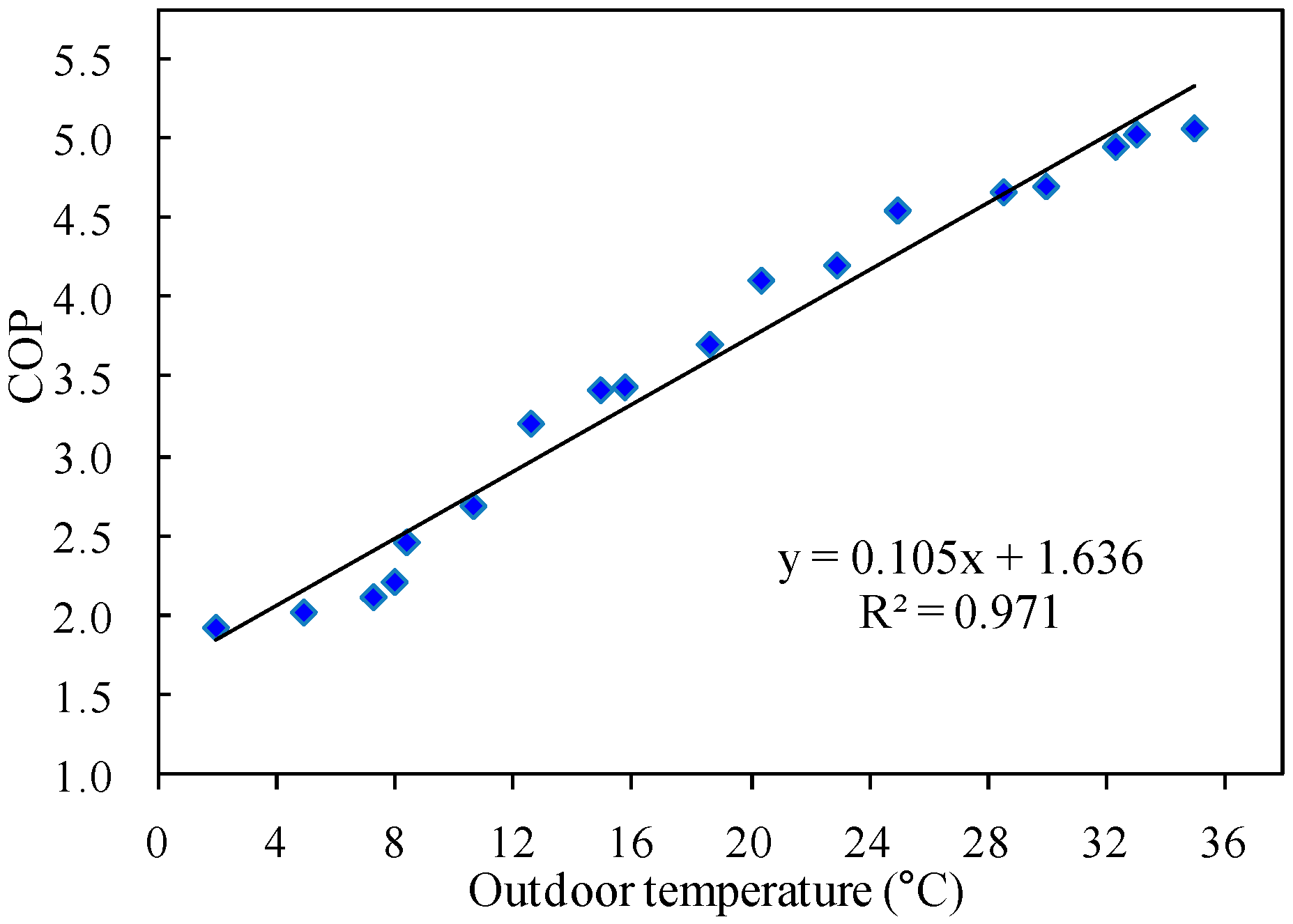

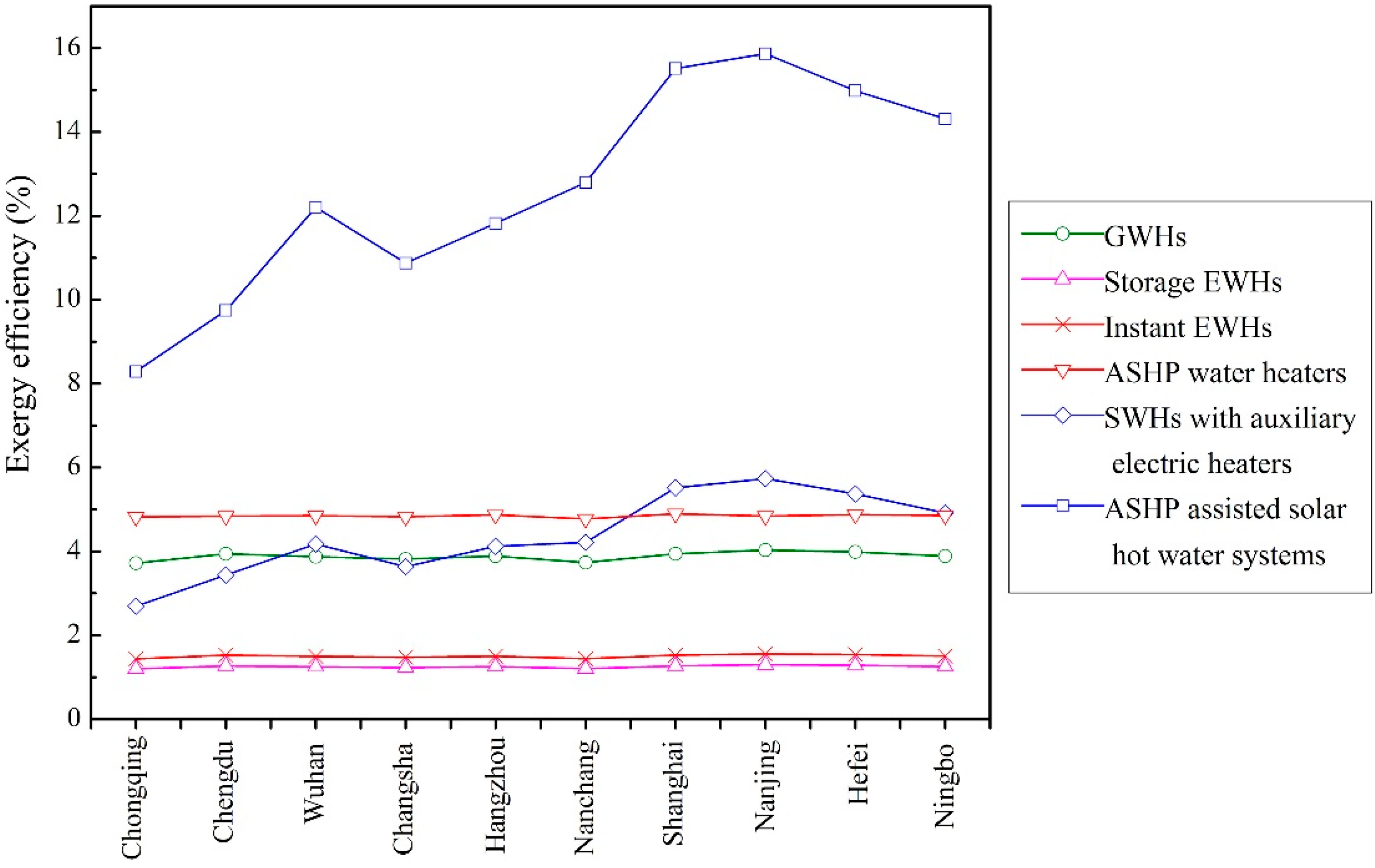
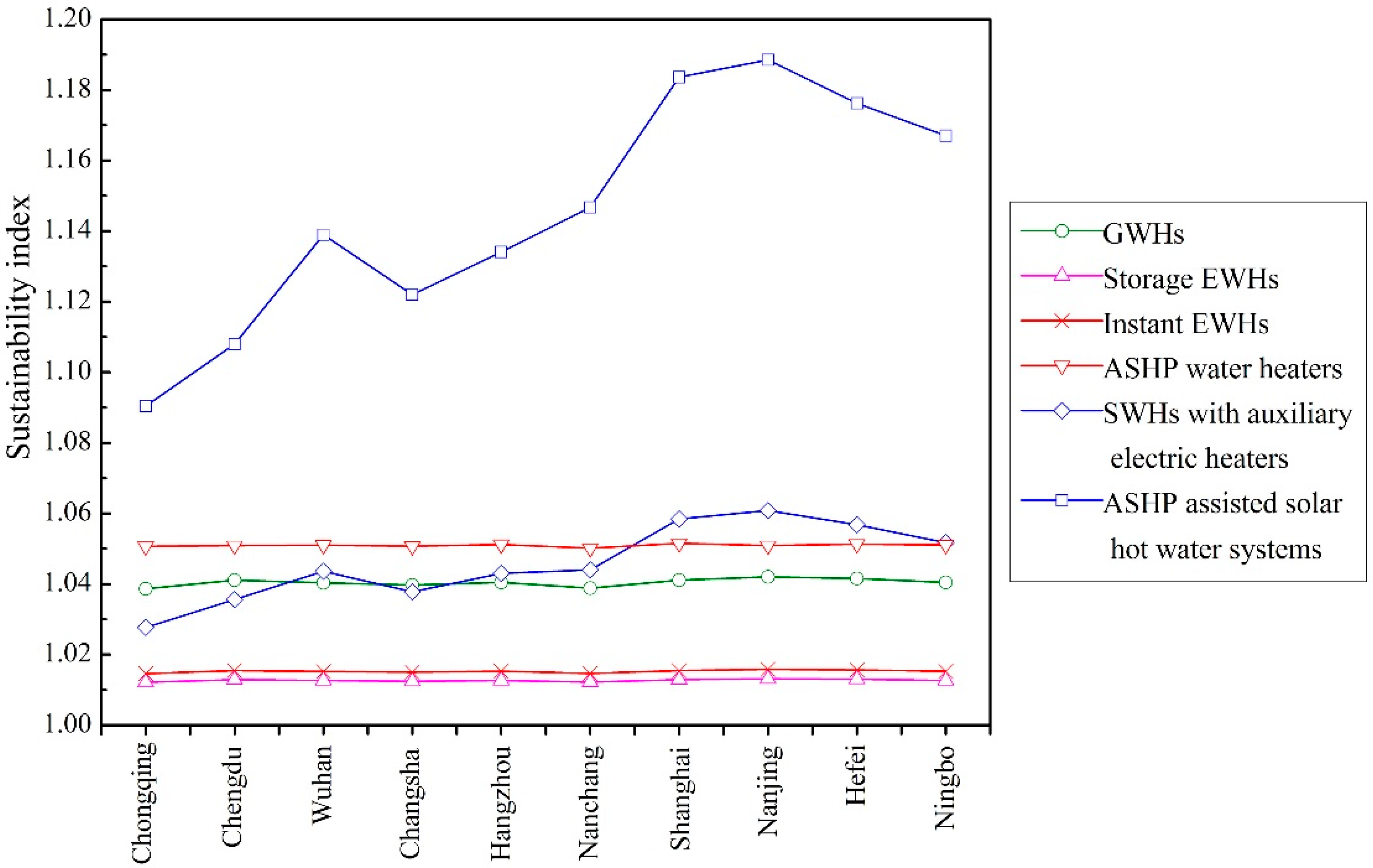
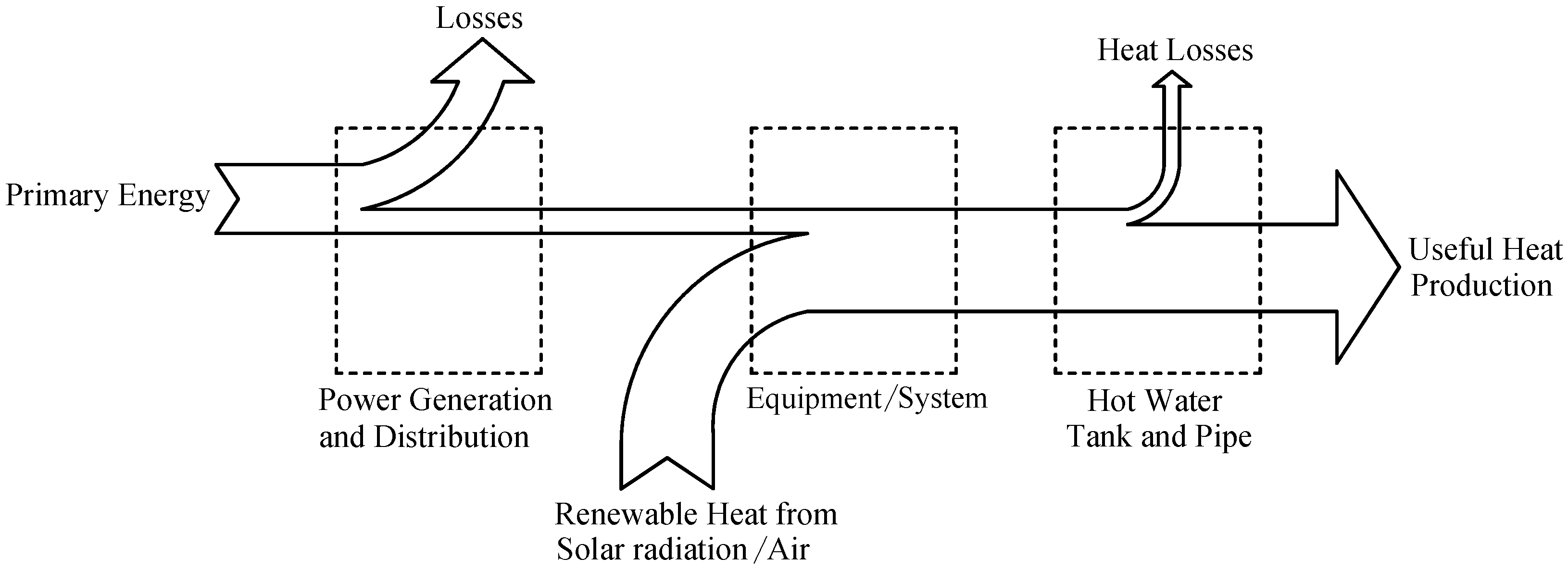
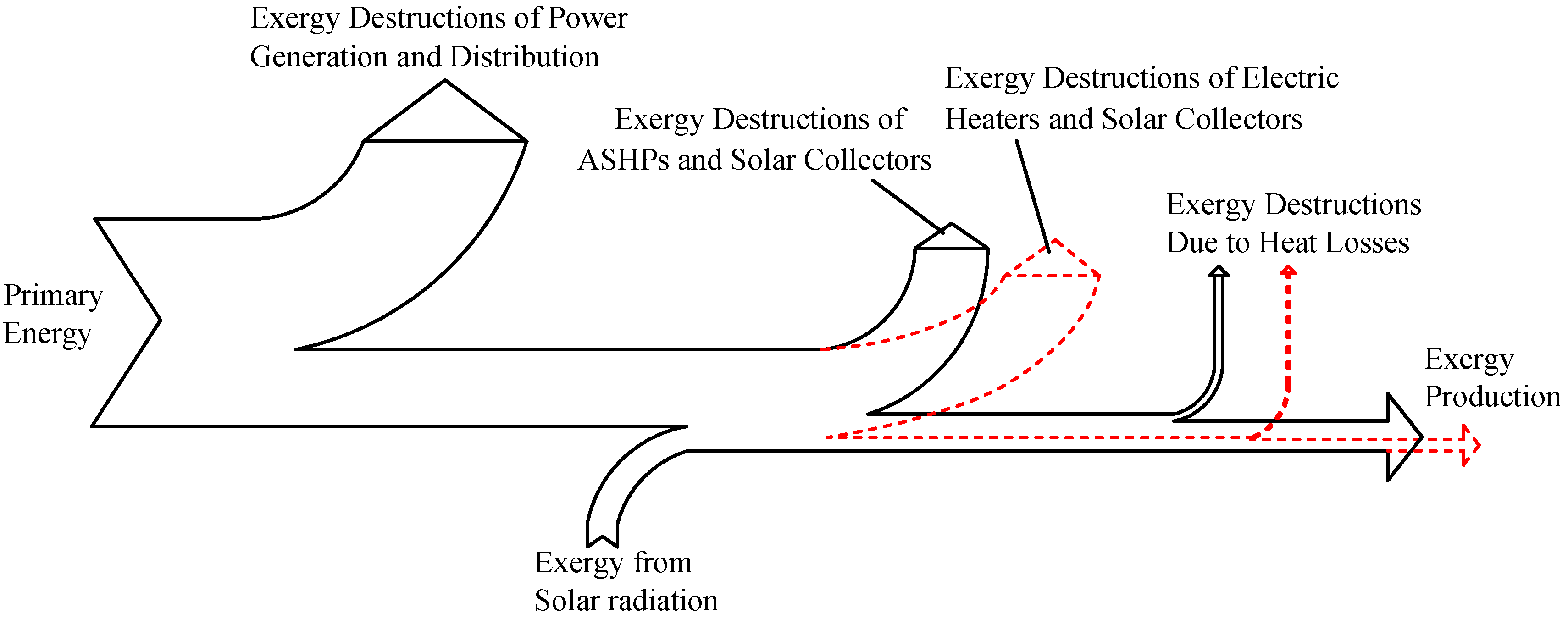
| City | AOT in the Hottest Month (°C) | AOT in Heating Season (°C) | Average RH in the Coldest Month (%) |
|---|---|---|---|
| Chongqing | 28.6 | 8.9 | 83 |
| Chengdu | 25.8 | 7.1 | 83 |
| Wuhan | 28.7 | 5.5 | 77 |
| Changsha | 29.3 | 6.2 | 83 |
| Hangzhou | 28.5 | 5.6 | 76 |
| Nanchang | 29.5 | 6.9 | 77 |
| Shanghai | 28.2 | 5.4 | 75 |
| Nanjing | 28.0 | 4.3 | 76 |
| Hefei | 28.2 | 4.4 | 76 |
| Ningbo | 28.3 | 5.8 | 79 |
| Sales (Units) | Proportion of Sales (%) | Possession Rate (%) | |
|---|---|---|---|
| Electric water heaters | 15,200,000 | 40 | 42 |
| Gas water heaters | 12,160,000 | 32 | 35 |
| Solar water heaters | 9,500,000 | 25 | 20 |
| Air-source heat pump water heaters | 1,106,000 | 3 | 3 |
| Totals | 37,966,000 | 100 | 100 |
| City | Annual Average IT (kJ/m2·d) | fa (%) | T0 (°C) | COPann | COPaux |
|---|---|---|---|---|---|
| Chongqing | 8552 | 54.6 | 17.7 | 3.55 | 2.77 |
| Chengdu | 9305 | 62.3 | 16.1 | 3.36 | 2.55 |
| Wuhan | 11,869 | 69.5 | 16.6 | 3.43 | 2.63 |
| Changsha | 11,061 | 65.5 | 17.0 | 3.46 | 2.69 |
| Hangzhou | 11,621 | 69.0 | 16.5 | 3.43 | 2.58 |
| Nanchang | 12,158 | 70.9 | 17.6 | 3.50 | 2.73 |
| Shanghai | 13,447 | 76.5 | 16.1 | 3.40 | 2.53 |
| Nanjing | 13,960 | 76.9 | 15.5 | 3.29 | 2.49 |
| Hefei | 13,240 | 75.6 | 15.8 | 3.35 | 2.51 |
| Ningbo | 12,721 | 74.0 | 16.5 | 3.42 | 2.62 |
| Parameter Values | η (%) | PEE (%) | Ψ (%) | SI | |
|---|---|---|---|---|---|
| ASHPs | HSPF = 2.3; T1,in = 6 °C; T1,out = 1.2 °C; T2,in = 18 °C; T2,out = 38 °C | 230 | 85.68 | 12.33 | 1.141 |
| Electric space heating | TN = 18 °C | 98 | 36.51 | 1.46 | 1.015 |
| Gas furnaces | |||||
| With radiators | Ts = 75 °C; Tr = 50 °C | 80 | 80 | 14.14 | 1.165 |
| With radiant floors | Ts = 45 °C; Tr = 38 °C | 80 | 80 | 9.50 | 1.105 |
© 2016 by the authors; licensee MDPI, Basel, Switzerland. This article is an open access article distributed under the terms and conditions of the Creative Commons Attribution (CC-BY) license (http://creativecommons.org/licenses/by/4.0/).
Share and Cite
Chen, X.; Wen, Y.; Li, N. Energy Efficiency and Sustainability Evaluation of Space and Water Heating in Urban Residential Buildings of the Hot Summer and Cold Winter Zone in China. Sustainability 2016, 8, 989. https://doi.org/10.3390/su8100989
Chen X, Wen Y, Li N. Energy Efficiency and Sustainability Evaluation of Space and Water Heating in Urban Residential Buildings of the Hot Summer and Cold Winter Zone in China. Sustainability. 2016; 8(10):989. https://doi.org/10.3390/su8100989
Chicago/Turabian StyleChen, Xiao, Yongquan Wen, and Nanyang Li. 2016. "Energy Efficiency and Sustainability Evaluation of Space and Water Heating in Urban Residential Buildings of the Hot Summer and Cold Winter Zone in China" Sustainability 8, no. 10: 989. https://doi.org/10.3390/su8100989
APA StyleChen, X., Wen, Y., & Li, N. (2016). Energy Efficiency and Sustainability Evaluation of Space and Water Heating in Urban Residential Buildings of the Hot Summer and Cold Winter Zone in China. Sustainability, 8(10), 989. https://doi.org/10.3390/su8100989





